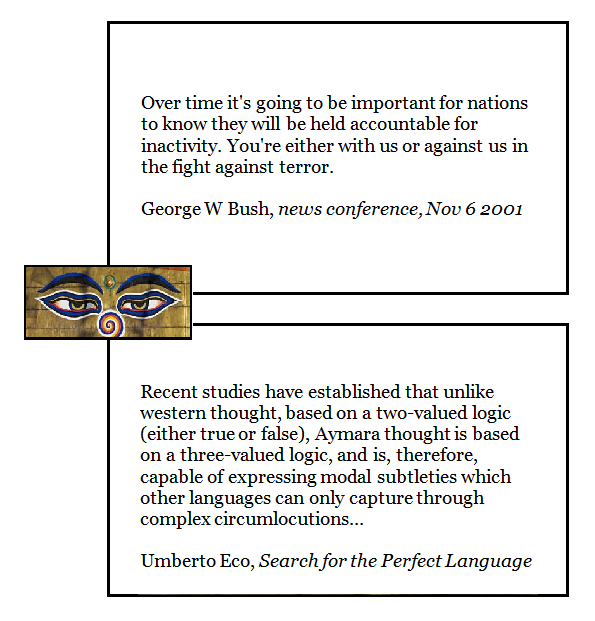[ by Charles Cameron — I thought it might be timely to consider trinary thinking in light of Zen‘s recent post featuring Clausewitz‘ Trinity ]
.
I know, it sounds inherently ridiculous, but what would happen if we thought in threes instead of twos? I mean, we tend to see things in terms of black and white, good and bad. Let’s set up a binary of our own — US President George W Bush vs the Aymara of the Andes and Altiploano:
Two into three won’t go, as they used to say in math class when I was a kid.
Hegel thought otherwise. Hegel thought two needed to move on into three, or we’d be stuck with binaries in stasis for ever. Hegel’s dialectic is about the possibility called three – which opens the otherwise static two up to various kinds of process…
**
We tend to view conflicts in binary terms: “who goes there, friend or foe?” is the challenge I was supposed to offer Mad Mitch the Axe Man if I ran across him as a CCF trainee in the grounds of my old school, Wellington College.
What is conflict is viewed in trinary?
Here is Chris Crawford, from his justly famous 1982 Art of Computer Game Design:
The advantage of asymmetric games lies in the ability to build nontransitive or triangular relationships into the game. Transitivity is a well-defined mathematical property. In the context of games it is best illustrated with the rock-scissors-paper game. Two players play this game; each secretly selects one of the three pieces; they simultaneously announce and compare their choices. If both made the same choice the result is a draw and the game is repeated. If they make different choices, then rock breaks scissors, scissors cut paper, and paper enfolds rock. This relationship, in which each component can defeat one other and can be defeated by one other, is a nontransitive relationship; the fact that rock beats scissors and scissors beat paper does not mean that rock beats paper.
We’re back in play…
**
Here, too, is a bit from m’friend Wm. Benzon, jazz-player, blogger, polymath:
Three against two is one of the most important rhythm ‘cells’ in all of music. What do I mean, three against two? You play three evenly spaced beats in one ‘stream’ in the same period of time you play two evenly spaced beats in another ‘stream.’ It sounds simple enough but, the problem is that three and two do not have a common divisor, making the ‘evenly spaced’ part of the formula a bit tricky. The two patterns coincide on the first beat, but the second and third beats of the three-beat stream happen at different times from the second beat of the two-beat stream. And if you think that’s a lot of verbiage for something that ought to be simple, when then you’re beginning to get the idea.
Noting that the brain has a hard time moving from two to three this way, Benzon quotes old-time piano virtuoso Joseph Hoffman:
In faster motion it is far better to practise at first each hand alone and with somewhat exaggerated accents of each group until the two relative speeds are well established in the mind. Then try to play the two hands together in a sort of semi-automatic way. Frequent correct repetition of the same figure will soon change your semi-automatic state into a a conscious one, and thus train your ear to listen to and control two different rhythms or groupings at the same time.
Those readers already familiar with my insistence on many-voiced (ie polyphonic) listening will quickly grasp that Hoffman is speaking of just that kind of broadening of our mental horizons — of our thinking capacities.
**
I’d like to close part 1 of this two part post within my “Numbers by the numbers” series, with a quote from LtGen Paul Van Riper (USMC Ret.), The Foundation of Strategic Thinking at Infinity Journal:
The United States and its allies need senior civilian officials and military officers who grasp the fundamental nature of systems, are adept at building shared mental models, comprehend the significance of Clausewitz’s paradoxical trinity, understand operational art and can connect strategic thinking with tactical actions through operational design. These are the true competencies of modern defense professionals.
As in conflict, as in Clausewitz, so in conflict resolution: we need to be able to think in trinary — in trinities — and beyond.
More on that — which interested me enough that I once designed a trinary game of my own, played with great splash and delight by three kids in a swimming pool — in the second part of this post.



